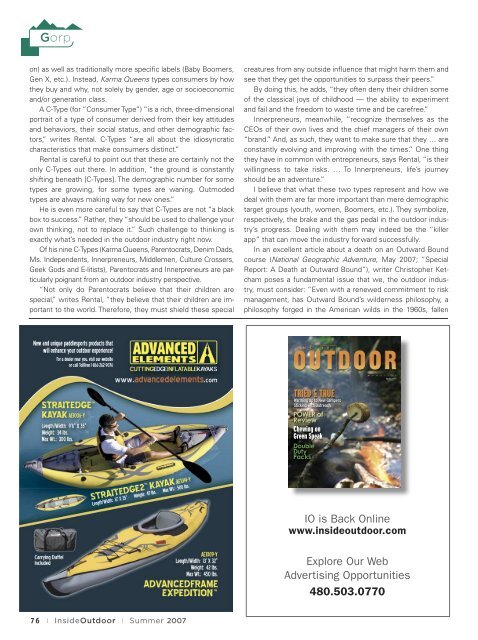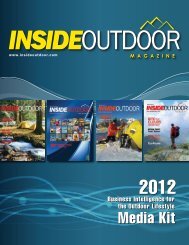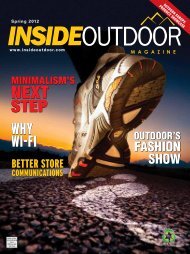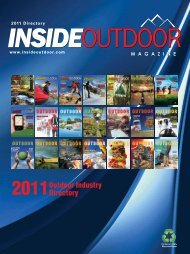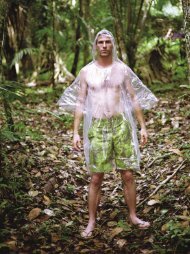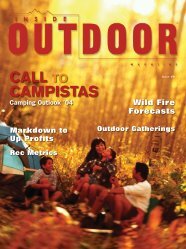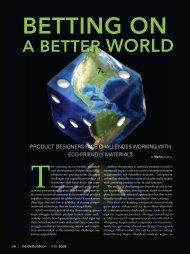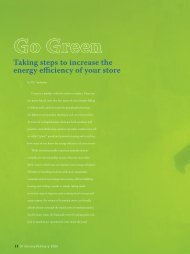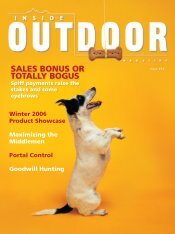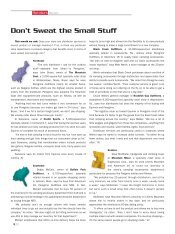Summer - InsideOutdoor Magazine
Summer - InsideOutdoor Magazine
Summer - InsideOutdoor Magazine
You also want an ePaper? Increase the reach of your titles
YUMPU automatically turns print PDFs into web optimized ePapers that Google loves.
Gorp<br />
on) as well as traditionally more specific labels (Baby Boomers,<br />
Gen X, etc.). Instead, Karma Queens types consumers by how<br />
they buy and why, not solely by gender, age or socioeconomic<br />
and/or generation class.<br />
A C-Type (for “Consumer Type”) “is a rich, three-dimensional<br />
portrait of a type of consumer derived from their key attitudes<br />
and behaviors, their social status, and other demographic factors,”<br />
writes Rental. C-Types “are all about the idiosyncratic<br />
characteristics that make consumers distinct.”<br />
Rental is careful to point out that these are certainly not the<br />
only C-Types out there. In addition, “the ground is constantly<br />
shifting beneath [C-Types]. The demographic number for some<br />
types are growing, for some types are waning. Outmoded<br />
types are always making way for new ones.”<br />
He is even more careful to say that C-Types are not “a black<br />
box to success.” Rather, they “should be used to challenge your<br />
own thinking, not to replace it.” Such challenge to thinking is<br />
exactly what’s needed in the outdoor industry right now.<br />
Of his nine C-Types (Karma Queens, Parentocrats, Denim Dads,<br />
Ms. Independents, Innerpreneurs, Middlemen, Culture Crossers,<br />
Geek Gods and E-litists), Parentocrats and Innerpreneurs are particularly<br />
poignant from an outdoor industry perspective.<br />
“Not only do Parentocrats believe that their children are<br />
special,” writes Rental, “they believe that their children are important<br />
to the world. Therefore, they must shield these special<br />
creatures from any outside influence that might harm them and<br />
see that they get the opportunities to surpass their peers.”<br />
By doing this, he adds, “they often deny their children some<br />
of the classical joys of childhood — the ability to experiment<br />
and fail and the freedom to waste time and be carefree.”<br />
Innerpreneurs, meanwhile, “recognize themselves as the<br />
CEOs of their own lives and the chief managers of their own<br />
“brand.” And, as such, they want to make sure that they … are<br />
constantly evolving and improving with the times.” One thing<br />
they have in common with entrepreneurs, says Rental, “is their<br />
willingness to take risks. … To Innerpreneurs, life’s journey<br />
should be an adventure.”<br />
I believe that what these two types represent and how we<br />
deal with them are far more important than mere demographic<br />
target groups (youth, women, Boomers, etc.). They symbolize,<br />
respectively, the brake and the gas pedal in the outdoor industry’s<br />
progress. Dealing with them may indeed be the “killer<br />
app” that can move the industry forward successfully.<br />
In an excellent article about a death on an Outward Bound<br />
course (National Geographic Adventure, May 2007; “Special<br />
Report: A Death at Outward Bound”), writer Christopher Ketcham<br />
poses a fundamental issue that we, the outdoor industry,<br />
must consider: “Even with a renewed commitment to risk<br />
management, has Outward Bound’s wilderness philosophy, a<br />
philosophy forged in the American wilds in the 1960s, fallen<br />
<br />
<br />
<br />
<br />
<br />
<br />
<br />
<br />
<br />
<br />
<br />
IO is Back Online<br />
www.insideoutdoor.com<br />
Explore Our Web<br />
Advertising Opportunities<br />
480.503.0770<br />
76 | <strong>InsideOutdoor</strong> | <strong>Summer</strong> 2007


